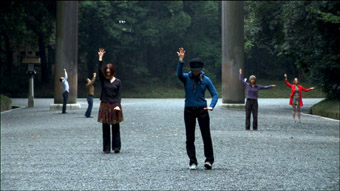 |
Will Time Tell?, by Sue Healey |
Sue Healey casts dancer Shona Erskine as the stranger in Tokyo. Her startling red costume is unsettling in its domination of the tonal palette, its searing colour mitigating against subtlety and complexity. It screams at me in every scene. But this costuming choice does transform Erskine into a superimposition, keeping her slightly unreal; separated from people, place and shared time. A train rushes behind her, blurred into abstraction: she is steadfast and still against this speed and the world behind her is made pallid against her loud and stolid tones. She is alone.
Disjunction, as the propelling narrative tension, is expressed as a manifestation of time in this wordless 12 minute film. The red coated woman is warped into slow time somewhere beyond stillness while Japanese locals are propelled into hyper speed, rushing in streams around and past her, throwing her into a solitary bubble, but also swallowing her in hubbub. Paradoxically, she at once stands out and is negated.
On a travelator Erskine dances quick and perky amidst the marked restraint and orderliness of dark suited workers, going about the business of a regular day in this regulated city. She is ahead of the game as she glides gaily across this landscape of plodding time. Now it is she who is oblivious, resisting the tempos of her environment: not just a victim to disjunction, but an active participant.
Healey manipulates filmic temporality to reiterate the essential constructed-ness of lived time. Perambulatory time, measured and object oriented, creates people who pass by, not seeing. Time spent in waiting becomes awkwardly lengthened and uncomfortable as the red coated woman stands on a corner that becomes a spatial and temporal intersection; she appears indecisive, almost fearful. Happy time is jumpy and so sadly brief. Time alone is maddeningly slow or restlessly yearning and time with friends dissolves into time alone again.
But there are moments when she enters this world. Short sequences of unison dancing that embody a Japanese delicacy and reveal the idiosyncratic detail of Healey’s choreographic skill. Erskine and a Japanese dancer come together in slow lateral sweeps of hands with gesturing fingers, making time stand still in a streetscape where movement is meant to get you somewhere. These simple and delicate gestures of dancers out of context are a lacuna in the fabric of regular time and space. Gentle unison binds these women as the traveller shares language with a local. But still the coat screams.
The dance of the hands is the point of most complete immersion. At last the coat is removed in a suggestion of cosiness and ease. This is the 'sex scene.' In a busy café, hands meet, slightly shaky, and mingle flesh, digits dancing. A lingering high view reveals differing skin tones: between man and woman, Caucasian and Asian, between palm and back of hand. The muted light of the restaurant softens the slow touching. I see the hands as the lovers do, from above and they become mine, my body drawn into the film just as the traveller is drawn temporarily into the warmth of intimacy. It is peaceful in its congruence, a relief in its contentment, so pleasurable in its sexuality, voyeuristic and intrusive in its proximity.
But this conjunction disappears quickly, her lover soon becoming just one in the crowd. A shop front mannequin is being dressed in her coat, ready for sale. Has she gone? Was she ever there?
Will Time Tell?, a film by Sue Healey in collaboration with performers Shona Erskine, Ryuichi Fujimura, Makiko Izu, Mina Kawai, Yuka Kobayashi, Norikazu Maeda, director of photography Mark Pugh, composer Ben Walsh, editor Peter Fletcher; 2006
© Pauline Manley; for permission to reproduce apply to [email protected]








 back
back